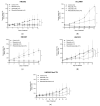Preclinical Evaluation of the Association of the Cyclin-Dependent Kinase 4/6 Inhibitor, Ribociclib, and Cetuximab in Squamous Cell Carcinoma of the Head and Neck
- PMID: 33809148
- PMCID: PMC7998503
- DOI: 10.3390/cancers13061251
Preclinical Evaluation of the Association of the Cyclin-Dependent Kinase 4/6 Inhibitor, Ribociclib, and Cetuximab in Squamous Cell Carcinoma of the Head and Neck
Abstract
Epidermal growth factor receptor (EGFR) overexpression is observed in 90% of human papillomavirus (HPV)-negative squamous cell carcinomas of the head and neck (SCCHN). Cell cycle pathway impairments resulting in cyclin-dependent kinase (CDK) 4 and 6 activation, are frequently observed in SCCHN. We investigated the efficacy of ribociclib, a CDK4/6 inhibitor, in combination with cetuximab, a monoclonal antibody targeting the EGFR, in HPV-negative SCCHN patient-derived tumor xenograft (PDTX) models. The combination of cetuximab and ribociclib was not significantly more active than cetuximab monotherapy in all models investigated. In addition, the combination of cetuximab and ribociclib was less active than ribociclib monotherapy in the cetuximab-resistant PDTX models. In these models, a significant downregulation of the retinoblastoma (Rb) protein was observed in cetuximab-treated mice. We also observed Rb downregulation in the SCCHN cell lines chronically exposed and resistant to cetuximab. In addition, Rb downregulation induced interleukin 6 (Il-6) secretion and the Janus kinase family member/signal transducer and activator of transcription (JAK/STAT) pathway activation that might be implicated in the cetuximab resistance of these cell lines. To conclude, cetuximab is not an appropriate partner for ribociclib in cetuximab-resistant SCCHN models. Our work has significant clinical implications since the combination of anti-EGFR therapy with CDK4/6 inhibitors is currently being investigated in clinical trials.
Keywords: CDK4/6; cetuximab; resistance; retinoblastoma; ribociclib; squamous cell carcinoma of the head and neck.
Conflict of interest statement
The authors declare no conflict of interest.
Figures






Similar articles
-
Preclinical Activity of Ribociclib in Squamous Cell Carcinoma of the Head and Neck.Mol Cancer Ther. 2020 Mar;19(3):777-789. doi: 10.1158/1535-7163.MCT-19-0695. Epub 2020 Jan 10. Mol Cancer Ther. 2020. PMID: 31924739
-
Phase 1 Study Evaluating the Association of the Cyclin-Dependent Kinase 4/6 Inhibitor Ribociclib and Cetuximab in Recurrent/Metastatic p16-Negative Squamous Cell Carcinoma of the Head and Neck.Front Oncol. 2019 Mar 19;9:155. doi: 10.3389/fonc.2019.00155. eCollection 2019. Front Oncol. 2019. PMID: 30941307 Free PMC article.
-
Potential role of cyclin-dependent kinase 4/6 inhibitors in the treatment of squamous cell carcinoma of the head and neck.Curr Opin Oncol. 2019 May;31(3):122-130. doi: 10.1097/CCO.0000000000000513. Curr Opin Oncol. 2019. PMID: 30986809 Review.
-
CDK4/6 inhibitors in P16/HPV16-negative squamous cell carcinoma of the head and neck.Eur Arch Otorhinolaryngol. 2020 May;277(5):1273-1280. doi: 10.1007/s00405-020-05891-2. Epub 2020 Mar 11. Eur Arch Otorhinolaryngol. 2020. PMID: 32162057 Review.
-
Predictors of ribociclib-mediated antitumour effects in native and sorafenib-resistant human hepatocellular carcinoma cells.Cell Oncol (Dordr). 2019 Oct;42(5):705-715. doi: 10.1007/s13402-019-00458-8. Epub 2019 Jun 27. Cell Oncol (Dordr). 2019. PMID: 31250364
Cited by
-
PPARα-mediated lipid metabolism reprogramming supports anti-EGFR therapy resistance in head and neck squamous cell carcinoma.Nat Commun. 2025 Feb 1;16(1):1237. doi: 10.1038/s41467-025-56675-3. Nat Commun. 2025. PMID: 39890801 Free PMC article.
-
Targeting PI3K/AKT/mTOR Signaling Pathway as a Radiosensitization in Head and Neck Squamous Cell Carcinomas.Int J Mol Sci. 2022 Dec 12;23(24):15749. doi: 10.3390/ijms232415749. Int J Mol Sci. 2022. PMID: 36555391 Free PMC article. Review.
-
Targeted therapy for head and neck cancer: signaling pathways and clinical studies.Signal Transduct Target Ther. 2023 Jan 16;8(1):31. doi: 10.1038/s41392-022-01297-0. Signal Transduct Target Ther. 2023. PMID: 36646686 Free PMC article. Review.
-
Practical Consensus Guidelines on the Use of Cetuximab in Head and Neck Squamous Cell Carcinoma (HNSCC).South Asian J Cancer. 2024 Oct 16;14(1):90-102. doi: 10.1055/s-0044-1791783. eCollection 2025 Jan. South Asian J Cancer. 2024. PMID: 40124157 Free PMC article.
-
The Renaissance of Cyclin Dependent Kinase Inhibitors.Cancers (Basel). 2022 Jan 7;14(2):293. doi: 10.3390/cancers14020293. Cancers (Basel). 2022. PMID: 35053461 Free PMC article. Review.
References
Grants and funding
LinkOut - more resources
Full Text Sources
Other Literature Sources
Research Materials
Miscellaneous

